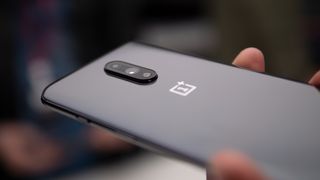OnePlus 7 hands-on review: No revelations, but no disappointments
OnePlus hasn’t changed much since the 6T, but maybe it doesn’t have to

For the first time since it emerged onto the scene a few years ago, Chinese company OnePlus has launched not one, not two, but three phones at simultaneous events in New York, Bangalore and London.
The headline-grabber is the OnePlus 7 Pro, a true flagship designed to rival the likes of the Samsung Galaxy S10+ and the Huawei P30 Pro. However, the company also launched a regular, non-Pro follow-up to the OnePlus 6T; the OnePlus 7.
OnePlus 7 hands-on review: Design
Visually-speaking, the OnePlus 7 is functionally identical to its predecessor, the 6T. Because it uses the same front-facing camera configuration as the 6T's teardrop notch rather than the 7 Pro's motorised pop-up module, it can't replicate the Pro's impressive notchless edge-to-edge display. On the other hand, if you're worried about the pop-up motor's potential for failure, this might put your mind at ease.
Sadly, the OnePlus 7 now only comes in one colour: the reflective 'Mirror Grey' finish. The Pro comes in two more colours, one of which the gorgeous Nebula Blue, which we'd have loved to see on the 7.
OnePlus 7 hands-on review: Display
Along with the true edge-to-edge display, another OnePlus 7 Pro feature that the OnePlus 7 lacks is the curved screen. Instead, it's still a regular, flat, 6.4in panel, with a fairly run-of-the-mill 1,080 x 2,340 resolution.

While the display looks good on first glance, there doesn't seem to be anything in particular to write home about, and we won't have a true indication of its quality until we can fully test it.
OnePlus 7 hands-on review: Specs & hardware
As with most two-tier launches, the OnePlus 7 and the 7 Pro both use the same internal hardware: the octa-core Qualcomm Snapdragon 855 SoC, coupled with either 6GB or 8GB of RAM depending on the configuration. Unlike the Pro, there's no 12GB option.
Get the ITPro. daily newsletter
Receive our latest news, industry updates, featured resources and more. Sign up today to receive our FREE report on AI cyber crime & security - newly updated for 2024.
The storage uses the UFS 3.0 standard for faster read write speeds and is available in either 128GB or 256GB versions. As always with OnePlus, there's no support for microSD card expansion. There's also a 3,700mAh battery, with support for OnePlus' Warp Charge 30 fast-charging technology.
OnePlus 7 hands-on review: Camera
As you may have guessed, the camera setup for the OnePlus 7 is effectively a stripped-back version of the one used on the 7 Pro. The main camera is the same; a 48-megapixel, f/1.7 lens with a Sony-built sensor, with a further 20-megapixel sensor that's used purely for depth-sensing duties. It doesn't have the telephoto or wide-angle lenses that the 7 Pro has, unfortunately.
The camera will, however, share features such as optical image stabilisation, as well as software features like the UltraShot photography engine and other enhancements. Initial camera tests certainly seem impressive, but we won't know for sure until we've had a chance to test it more extensively.
OnePlus 7 hands-on review: Early verdict
If the OnePlus 7 Pro is a decided step-change, the 'vanilla' OnePlus 7 is much more of an incremental upgrade. Aside from the camera and the processor, there isn't a whole lot that's radically different compared to the OnePlus 6T.
We're inclined to be charitable about this, however, mostly because the price hasn't changed either. It still starts at 499 for the cheapest configuration, and will go on sale in June. The lack of a price hike buys it a fair amount of goodwill and (although we can't draw any final conclusions until we've done a full review), this phone looks to be just as good as the last OnePlus. Whether it's significantly better, however, remains to be seen.
Adam Shepherd has been a technology journalist since 2015, covering everything from cloud storage and security, to smartphones and servers. Over the course of his career, he’s seen the spread of 5G, the growing ubiquity of wireless devices, and the start of the connected revolution. He’s also been to more trade shows and technology conferences than he cares to count.
Adam is an avid follower of the latest hardware innovations, and he is never happier than when tinkering with complex network configurations, or exploring a new Linux distro. He was also previously a co-host on the ITPro Podcast, where he was often found ranting about his love of strange gadgets, his disdain for Windows Mobile, and everything in between.
You can find Adam tweeting about enterprise technology (or more often bad jokes) @AdamShepherUK.





